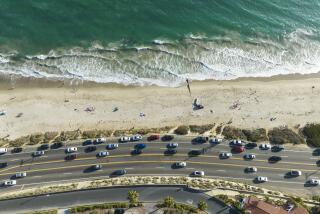Oil Washes Into Wetlands as Spill Barrier Collapses
- Share via
In what officials call the worst environmental damage since the Feb. 7 oil spill from a tanker off Huntington Beach, an earthen dam built to protect a sensitive wetlands area collapsed Sunday under a high tide and heavy surf, allowing large amounts of crude to wash over the preserve.
Work crews late Sunday hastened to restore the berm, but Huntington Beach Fire Chief Ray Picard said untold damage already had been done.
While no exact assessment has been made, Picard said early estimates are that mousse-like globs of brown oil covered 5% of the wetlands, while an oily sheen could be seen over much of the rest.
Officials of British Petroleum, owners of the 394,000 gallons of Alaskan crude that spilled from the tanker, said Sunday that tests were being performed on the oil to determine if it was from the vessel. The firm had been involved in what it described as its final mop-up of the major spill when Sunday’s setback occurred.
“It’s a severe blow,” Picard said. “From an environmental standpoint, this is the worst that has happened since the spill.”
The damage to wildlife was also difficult to tally.
Shortly after the discovery, members of a local environmental group dedicated to the preservation of the so-called Huntington Beach Wetlands rescued two oil-covered birds and deployed volunteers in boats to search for any more in the seven islands that constitute the preserve. Scores of rock-clinging mussels could be seen blackened with oil along a channel leading to the wetlands.
“When I got here this morning, the fish were jumping like crazy trying to get out of the oil,” Louann Murray, a member of the Huntington Beach Conservancy environmental group, said Sunday.
The wetlands encompass a 25-acre saltwater marsh near the Santa Ana River mouth that is part of the Pacific flyway for migrating waterfowl.
Restored last year after being partially filled in since the 1950s, the region is home to crabs, fish, shore birds and coastal plants. Among the creatures is the endangered Belding’s Savannah sparrow.
Ever since the tanker American Trader ruptured on its anchor while attempting to unload at an underwater mooring terminal, authorities have struggled to keep the oil out of wetlands areas between Huntington Beach and Newport Beach.
Using earthen dams, sandbags and containment booms, the efforts had been largely successful until shortly before 9 a.m. Sunday, when a six-foot tide strengthened by six-foot waves created a tidal surge that raced up the Talbert Channel leading to the Huntington Beach Wetlands. The onslaught destroyed an eight-foot earthen dike that had been reinforced by hundreds of sandbags. A dozen absorbent booms placed on both sides of the dike were also broken to pieces.
After the dike broke, a five-foot wall of water roared into the wetlands, situated about 200 yards inland and just north of the Santa Ana River, said Victor Leipzig, a Huntington Beach city planner and Cypress College biology professor who has been heading up the volunteer rescue efforts following the spill.
The dam collapsed in full view of Leipzig and scores of spill cleanup workers, powerless to do anything to stop it.
Assessing the damage, Leipzig said all seven islands in the wetlands were surrounded by “bathtub-like” oil rings. He declined to speculate on the potential damage, although state and federal officials have said that cleaning oil from a wetlands area is so difficult that oily residue could linger for years.
The eight-foot high dike had been designed to withstand an average tide. Sunday’s tide was six feet above average, and the highest of the month, Picard said.
Pete Dalquist, an Orange County engineer who designed the dam, said he and other officials had been forewarned Saturday about the predicted high tides for Sunday, but had no idea that the surf would be so strong.
As tidal waters receded late Sunday morning, work crews supervised by British Petroleum officials moved bulldozers and other heavy equipment into place to rebuild the dam.
British Petroleum officials said they could not estimate how long it would take to clean up the latest mess.
“It will put us a little behind schedule,” said British Petroleum spokeswoman Marcia Meermans.
“There is some concern that this (oil) may have been from an upstream source,” Meermans said. “Nonetheless, we have people on scene.”
The petroleum company had been in what it described as its final mop-up of the Orange County coastline with the goal of reopening to the public 10 miles of beaches closed between Huntington Beach and Newport Beach. There was no indication Sunday when that might be.
More to Read
Sign up for Essential California
The most important California stories and recommendations in your inbox every morning.
You may occasionally receive promotional content from the Los Angeles Times.













